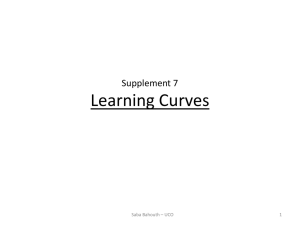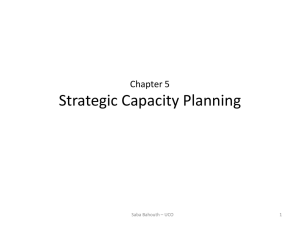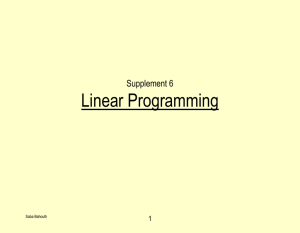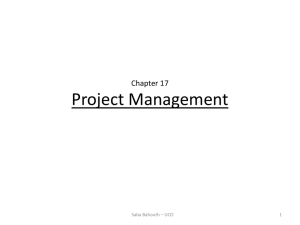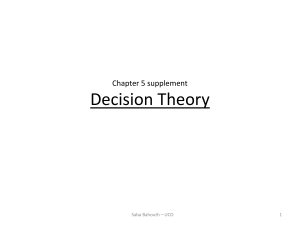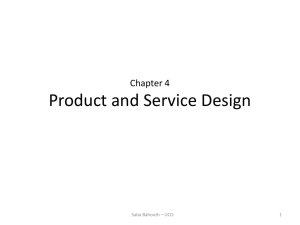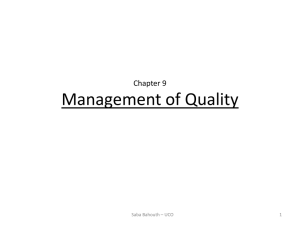Introduction to - UCO College of Business
advertisement
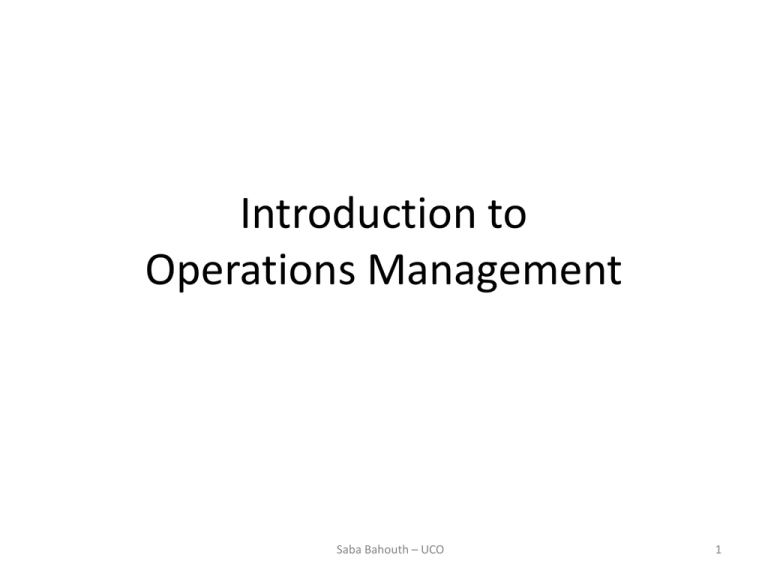
Introduction to Operations Management Saba Bahouth – UCO 1 What is Operations Management? • Production is the creation of goods and services • Operations management is the set of activities that creates value in • Operations management is the science and art of ensuring that • Operations Management is the management of systems or • OM’s principles help one to view a business as a total system: activities are coordinated vertically and horizontally across functions. • Operations Management affects: – Companies’ ability to compete – Nation’s ability to compete internationally the form of goods and services by transforming input into output. goods and services are created and delivered successfully to customers. processes that create goods and/or provide services (Stevenson) Saba Bahouth – UCO 2 A simple system Value added Inputs Land Labor Capital Transformation/ Conversion process Outputs Goods Services Feedback Control Feedback Feedback Saba Bahouth – UCO 3 Marketing Operations © 1995 Corel Corp. Finance © 1995 Corel Corp. Saba Bahouth – UCO 4 Saba Bahouth – UCO 5 Function vs. Process Saba Bahouth – UCO 6 Customer Benefit Package Saba Bahouth – UCO 7 Percentage of Job Creation: 80 – 20 Percentage of Output: 70% of what we export Productivity: Saba Bahouth – UCO 8 Basic Differences (But Cliches!) Manufacturing Service Labor content low Labor content high Mechanization / Automation high Mechanization / Automation low Customer contact low Customer contact high Can be resold Reselling unusual Can be easily inventoried Difficult to inventory Easy to evaluate work Difficult to evaluate work Quality easily measurable Quality difficult to measure Selling is distinct from production Selling is part of service provider Product is transportable Product is not transportable Site of facility important for cost Site of facility important for contact Easy to patent Difficult to patent Saba Bahouth – UCO 9 Evolution of Operations Management • Industrial revolution (1770’s) – Steam Engine; Coal and Iron; Standard parts and Products; Mass Production; Economies of Scale. Later: refinement of Steel (1855 by Henry Bessemer) • Scientific management (1911) – Frederick Taylor: The Principles of Scientific Management (1911) – Henry Ford introduced “Mass Production” by using Assembly Lines and: • Frederick Taylor’s principles • Eli Whitney’s ideas of Interchangeable Parts (late 1700) • Adam Smith’s ideas of Division of Labor (The Wealth of Nations – 1776) – Frank and Lillian Gilbreth (motion studies); Henry Gantt (scheduling) • Human relations movement – Gilbreths (Human Factor-1920s); Elton Mayo (Motivation/Productivity-1930s); Abraham Maslow (Motivational Theory-1940s); Douglas McGregor (Theory X / Theory Y-1960s); William Ouchi (Theory Z-1970s) • Decision models / Management Science / Quantitative Approaches • Influence of Japanese manufacturers – Continuous Quality Improvement; Teams; Empowerment; Customer Satisfaction; JIT Saba Bahouth – UCO 10 Tools for Decision Making in Operations • Models: • Quantitative approaches: • Analysis of trade-offs / Establishing priorities: • Systems approach: Performance Metrics: Profit; Productivity; Quality; Inventory; Schedule; Costs Saba Bahouth – UCO • Physical • Schematic • Mathematical • Inventory models: Harris-1915 • Queuing Techniques: Erlang-1920s • Linear programming: Dantzig-1940s • Project models: Late 1950s • Statistical models / Forecasting • Pareto Phenomenon; 80 - 20 • Break even Analysis • No Sub-optimization • The whole is greater than the sum of the parts 11 $ Revenues Models Costs Quantity x Three commonly known types of models: 1. Physical Models 2. Schematic Models 3. Mathematical Models Breakeven Mathematical Models We can find the break-even point by developing a simple mathematical model. Let x be the sales volume at the break-even point. Then Total cost = 100,000 + 12x Total revenue = 20x. Setting the total revenue equal to total cost we have 100,000 + 12x = 20x Hence: x = 12,500. If sales are less than 12,500 units, the firm will incur a loss; If sales are more than 12,500, a profit will be realized. Saba Bahouth – UCO 12 Trends in Business Operations – – – – – – – – – – – – The Internet, e-commerce, e-business Management of technology Globalization Management of supply chains Outsourcing Agility Ethical behavior Operations strategy Working with fewer resources – Lean Revenue management Process analysis and improvement Increased regulation and product liability Middle man; ERP Federal Labs NAFTA – Miata – US vs Japan Cars Low Bids vs Partnerships - JIT On time vs Fast Delivery - Thailand - Singapore Low Cost vs Environment - Water Bottles Electronics - 70-30 - VCR/HDTV - Lee Iacocca 1 Standard Products vs Mass Customization Reengineering: Michael Hammer Saba Bahouth – UCO 13

